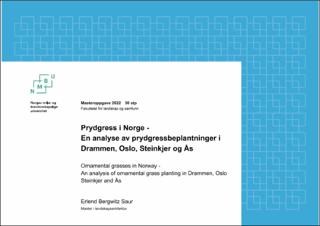| dc.contributor.advisor | Line Rosef | |
| dc.contributor.author | Saur, Erlend Bergwitz | |
| dc.date.accessioned | 2023-02-11T17:27:16Z | |
| dc.date.available | 2023-02-11T17:27:16Z | |
| dc.date.issued | 2022 | |
| dc.identifier | no.nmbu:wiseflow:6726681:52493213 | |
| dc.identifier.uri | https://hdl.handle.net/11250/3050132 | |
| dc.description.abstract | I denne oppgaven ble prydgressbeplantninger på 15 områder i Drammen, Oslo, Steinkjer og Ås undersøkt. Det ble undersøkt: 1) hvilke
prydgressarter som brukes i Norge, 2) hvordan og hvorfor artene som blir brukt klarer seg, og 3) muligheter og utfordringer ved bruk av disse
artene i norske anlegg. Prydgressene ble vurdert ut fra faktorene helhet, solforhold, hvor vindutsatt prydgresset stod og hvor høy dekningsgrad
av bunnen plantene hadde. I tillegg ble det undersøkt om plassering i kontainer eller jord, eller plassering i nærheten av benk påvirket
prydgresset, og vurderingene ble satt i sammenheng med det ulike klimaet i de fire kommunene.
Det ble funnet en smal artspalett, der to varieteter av Calamagrostis x acutiflora, Molinia caerulea og underarten Molinia caerulea ssp.
arundinacea, samt Deschampsia cespitosa og varieteten Deschampsia cespitosa ‘Goldschleier’, står for 89% av individene i
prydgressbeplantningen på de 15 områdene som ble undersøkt i Drammen, Oslo, Steinkjer og Ås. De resterende 11% av prydgressindividene
var fordelt på til sammen 11 arter.
Av de totalt 115 registreringene som ble gjort, ble det funnet at sammenhengen mellom prydgressets plassering ved benk ikke påvirket
helheten. I tillegg ble det heller ikke funnet at plassering i kontainer eller jord påvirket helheten på prydgressene.
Det blir gjennomgått spesifikke utfordringer for hver av de 17 artene som ble registrert, samt generelle utfordringer for prydgressbed på 15
områder i Drammen, Oslo, Steinkjer og Ås.
Konklusjonen ble at prydgressindividene som blir beplantet på de utvalgte områdene har i gjennomsnitt god helhet. Samtidig har flere av
registreringene artspesifikke forbedringspotensial for å øke helhetsintrykket, og det er mulighet for å optimalisere plasseringen av
prydgressartene i bedene og prydgressets samspill med andre planter. | |
| dc.description.abstract | In this thesis, plantings of Ornamental grasses are examined in 15 areas, in Drammen, Oslo, Steinkjer and Ås. It is examined 1) which species
of ornamental grasses are used in Norway, 2) why and how the species in question performs well, and 3) opportunities and challenges with the
use of these species in Norwegian facilities. The ornamental grasses were evaluated based on the factors total impression, solar conditions,
wind conditions and how much ground coverage the plants produced. In addition, it was investigated whether placement in containers or soil, or
placement near benches affected the ornamental grass, and the evaluation were put in context of the different climates in the four
municipalities.
A narrow palette of species was found, in which two varieties of Calamagrostis x acutiflora, Molinia caerulea and the subspecies Molinia caerulea
ssp. arundinacea, as well as Deschampsia cespitosa and the variety Deschampsia cespitosa ‘Goldschleier’, accounted for 89% of the total
individuals found in ornamental grassplanting in the 15 areas surveyed in Drammen, Oslo, Steinkjer and Ås. The remaining 11% of the ornamental
grass individuals consisted of a total of 11 species.
From the 115 registrations made, it was found that the correlation between the placement of ornamental grasses next to benches did not affect
the total impression. Furthermore, did neither the placement in containers or soil affect the total impression of the ornamental grasses
Specific challenges were reviewed for each of the 17 species that were registered, as well as general challenges for plantings containing
ornamental grasses in the four municipalities. The conclusion is that the individuals of ornamental grasses that are planted in the selected
places, receive on average a good total impression. At the same time, several of the registrations have a potential for specific improvements in
total impression for each species, and it is possible to optimize the way ornamental grasses are placed in plantings and their interaction with
other plants. | |
| dc.language | nob | |
| dc.publisher | Norwegian University of Life Sciences | |
| dc.title | Prydgress i Norge - En analyse av prydgressbeplantninger i Drammen, Oslo, Steinkjer og Ås | |
| dc.type | Master thesis | |
